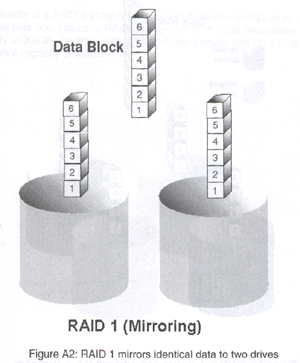RAID 1
Although speed can be an important aspect of computing, so can the security that comes with fault tolerance. Speed may be sacrificed but RAID 1 provides users with a whole new level of security.
RAID 1 works by writing identical sets of information to two drives in an array. When the controller is sent a 64KB file to be written to a two disk RAID 1 array, the controller sends identical copies of this 64KB file to both disks in the array. Reads are the same as on a single drive: the controller requests the file from one of the two drives.

Image courtesy of Promise Technology, Inc.
The special feature of RAID 1 is its fault tolerance. If either of the two drives in the array fails, no data is lost. If/when a drive fails, the RAID controller simply uses the information off of the drive that is still available. When a new drive is added to the array to fix the failed one, a mirroring occurs in which the data from the good drive is written to the new drive to recreate the array again.
As one could suspect, RAID 1 offers very little in terms of performance. When requesting data from a drive, some RAID controllers take information from the drive that is not busy or closer to the desired information, theoretically resulting in faster data access. When writing, on the other hand, there is some overhead when compared to a single drive as the controller must duplicate the file it is sent and then pass it along to the drives.
In a RAID 1 setup, identical drives are best in order to prevent lost space. Since the same data is being written to two drives, the size of the RAID 1 array is equal to the size of the smallest drive in the array. For example, if a 20GB drive and a 30GB drive are used in a RAID 1 setup, the array would only be 20GB with the 10 extra gigabytes on the 30GB drive going to waste. The performance difference between two drives is also an issue here, since a faster drive would have to wait for a slower drive before it could write more information.
RAID 1 is a good solution for those looking for security over speed. Although not the slowest of the common RAID types, RAID 1 can be slower than a single drive in some cases (more on that in the benchmarks). What RAID 1 does provide is a very safe environment, where failure of a single drive does not equate to any down time.










2 Comments
View All Comments
kburrows - Thursday, December 4, 2003 - link
Have you run any tests on any onboard RAID solutions for RAID 0 & 1? I would love to see the results posted for the new SATA RAID on the Intel 875 boards.Anonymous User - Sunday, August 17, 2003 - link
In adressing the performance of an raid array with different stripe sizes, you miss an important factor, namely the accestime of an disk. This wait time has two main couses. First the head positioning and second the rotational latency (the heads track the right trace, but position where the read start has not passed under the head). You may have to wait from 0 to (in the worst case) a full cycle.Since the disks move independently You can calculate that the average latency to get an small file is minimal when the stripe size is about an full cycle of an disk in the array (aprox. 250kB today). All other factors I do know do not reduce this. (controller overhead, transport,...)
So I think that today a minimum stripe size of 256kB should be used.